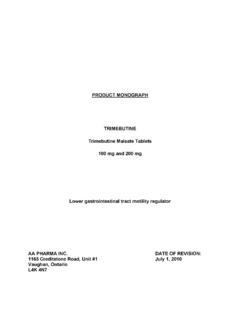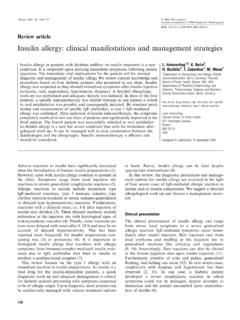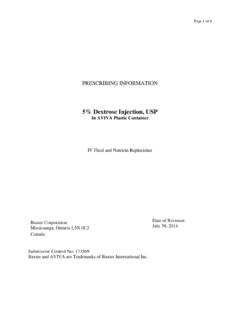Transcription of PRODUCT MONOGRAPH GLICLAZIDE MR - AA Pharma
1 Page 1 of 52 PRODUCT MONOGRAPH PrGLICLAZIDE MR GLICLAZIDE Modified Release Tablets 30 mg Hypoglycemic sulfonylurea - Oral antidiabetic agent AA Pharma INC. 1165 Creditstone Road, Unit #1 Vaughan, ON L4K 4N7 Date of Preparation: June 25, 2010 Control No: 139545 Page 2 of 52 Table of Contents PART I: HEALTH PROFESSIONAL SUMMARY PRODUCT INDICATIONS AND CLINICAL WARNINGS AND ADVERSE DRUG DOSAGE AND ACTION AND CLINICAL STORAGE AND DOSAGE FORMS, COMPOSITION AND PART II: SCIENTIFIC PHARMACEUTICAL CLINICAL DETAILED PART III: CONSUMER Page 3 of 52 PrGLICLAZIDE MR GLICLAZIDE Modified Release Tablets PART I.
2 HEALTH PROFESSIONAL INFORMATION SUMMARY PRODUCT INFORMATION Route of Administration Dosage Form / Strength Clinically Relevant Nonmedicinal Ingredients Oral 30 mg For a complete listing see Dosage Forms, Composition and Packaging section. INDICATIONS AND CLINICAL USE GLICLAZIDE MR is indicated for: Control of hyperglycemia in GLICLAZIDE responsive diabetes mellitus of stable, mild, non-ketosis prone, maturity onset or adult type which cannot be controlled by proper dietary management and exercise, or when insulin therapy is not appropriate. Geriatrics (> 65 years of age): The efficacy and tolerance of GLICLAZIDE MR, prescribed using the same therapeutic regimen in subjects over 65 years, has been confirmed in clinical trials.
3 The dosage will therefore be identical to that recommended for adults under the age of 65 years. Pediatrics (< 18 years of age): Safety and effectiveness of GLICLAZIDE MR in children have not been established. GLICLAZIDE MR is therefore not recommended for use in children and adolescents. CONTRAINDICATIONS GLICLAZIDE MR is contraindicated in patients with: Known hypersensitivity or allergy to GLICLAZIDE , other sulfonylureas, sulfonamides, or to any of the excipients of this PRODUCT . (For a complete listing see DOSAGE FORMS, Page 4 of 52 COMPOSITION AND PACKAGING SECTION). Unstable and/or insulin -dependent diabetes mellitus, particularly juvenile diabetes, diabetic ketoacidosis, diabetic pre-coma and coma.
4 During stress conditions such as serious infection, trauma or surgery. In the presence of severe liver disease or renal impairment (see WARNINGS AND PRECAUTIONS) Treatment with miconazole via systemic route or oromucosal gel (see DRUG-DRUG INTERACTIONS). Pregnancy and lactation (see WARNINGS AND PRECAUTIONS, Special Population, Pregnant Women and Nursing Women). WARNINGS AND PRECAUTIONS General Use of GLICLAZIDE MR ( GLICLAZIDE ) must be considered as treatment in addition to proper dietary regimen and not as substitute for diet. Careful selection of patients is important. It is imperative that there be rigid attention to diet, careful adjustment of dosage and instruction of the patient on hypoglycemic reactions, their recognition, remedies and control as well as regular, thorough medical follow-up.
5 Since the effects of oral hypoglycemic agents on the vascular changes and other long-term sequelae of diabetes mellitus are not fully known, patients receiving such drugs must be closely observed for both short- and long-term complications. Periodic assessment of cardiovascular, ophthalmic, renal and hepatic status is advisable. GLICLAZIDE MR use is not recommended with medications containing alcohol, phenylbutazone (systemic route) and danazol and precautions are required when used with chlorpromazine, glucocorticoids, ritodrine, salbutamol, terbutaline and anticoagulant therapy (see DRUG-DRUG INTERACTIONS).
6 Carcinogenesis and Mutagenesis Page 5 of 52 See Toxicology Endocrine and Metabolism Hypoglycemic reactions As with other sulfonylurea drugs, manifestations of hypoglycemia including dizziness, lack of energy, drowsiness, headache and sweating have been observed and weakness, nervousness, shakiness and paresthesia have also been reported. All sulfonylurea drugs can induce severe hypoglycemia. Particularly susceptible are elderly subjects, patients with impaired hepatic or renal function, those who are debilitated or malnourished and patients with primary or secondary adrenal insufficiency.
7 Some cases may be severe and prolonged. Hospitalisation may be necessary and glucose administration may need to be continued for several days. Hypoglycemia may be difficult to recognize in elderly patients and in patients receiving beta-blockers. Possible other symptoms of hypoglycemia are: intense hunger, nausea, vomiting, lassitude, sleep disorders, agitation, aggression, poor concentration, reduced awareness and slowed reactions, depression, confusion, visual and speech disorders, aphasia, tremor, paresis, sensory disorders, feeling of powerlessness, loss of self-control, delirium, convulsions, shallow respiration, bradycardia, drowsiness and loss of consciousness, possibly resulting in coma and lethal outcome.
8 In addition, signs of adrenergic counter-regulation may be observed: clammy skin, anxiety, tachycardia, hypertension, palpitations, angina pectoris and cardiac arrhythmia. This treatment should only be prescribed if the patient is likely to have a regular food intake (including breakfast). It is important to have a regular carbohydrate intake due to the increased risk of hypoglycemia if a meal is taken late, if an inadequate amount of food is consumed or if the food is low in carbohydrate. Hypoglycemia is more likely to occur during periods of low-calorie diet, following prolonged or strenuous exercise, following alcohol intake or during the administration of a combination of hypoglycemic agents.
9 Usually, hypoglycemic symptoms disappear after intake of carbohydrates (sugar). However, artificial sweeteners have no effect. Experience with other sulphonylureas shows that hypoglycemia can recur even when measures prove effective initially. Page 6 of 52 If a hypoglycemic episode is severe or prolonged, and even if it is temporarily controlled by intake of sugar, immediate medical treatment or even hospitalization are required. Other factors which increase the risk of hypoglycemia are: overdose of GLICLAZIDE MR, certain endocrine disorders (thyroid disorders, hypopituitarism and adrenal insufficiency) as well as withdrawal of prolonged and/or high dose corticosteroid therapy, severe vascular disease (severe coronary heart disease, severe carotid impairment, diffuse vascular disease) and concomitant administration of certain medicines (See DRUG-DRUG INTERACTIONS).
10 Poor Blood Glucose Control: The efficacy of GLICLAZIDE , in reducing glucose to the desired level decreases over a long period of time in many patients: this may be due to progression in the severity of the diabetes, or to a reduced response to treatment. This phenomenon is known as secondary failure and should be distinguished from primary failure, when the drug is ineffective when prescribed as first-line treatment. Adequate dose adjustment and compliance with dietary measures should be considered before classifying the patient as secondary failure. If a loss of adequate blood glucose-lowering response to GLICLAZIDE MR is detected, the drug should be discontinued.




